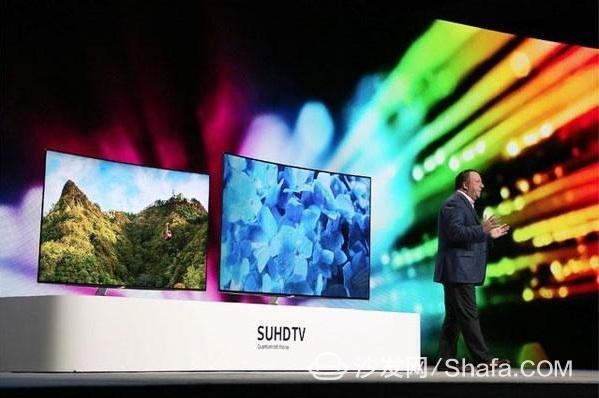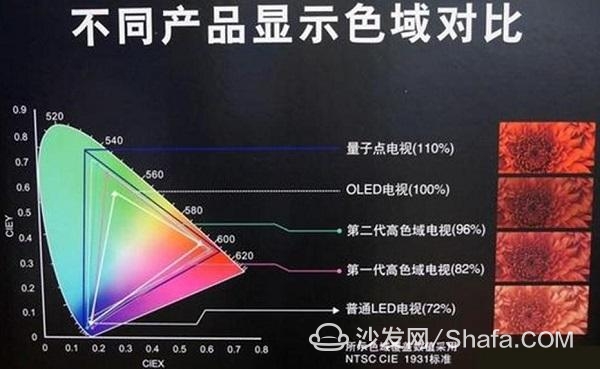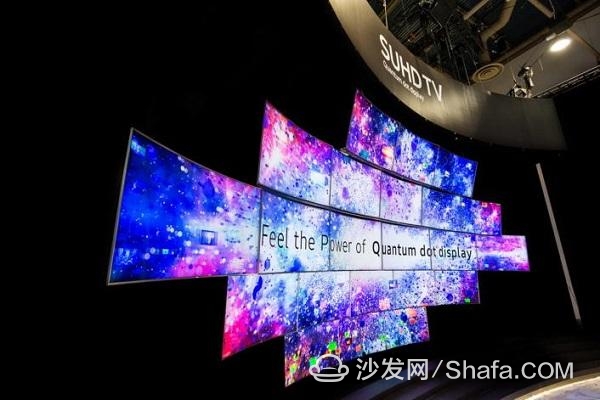The dispute between QDs and OLEDs who are more representative of the development trend of display technology has intensified. The Southern Metropolis Daily has recently published articles related to the rise of the two major display technologies to the height of the “birth and death examinationâ€, showing that between the two camps The fierce competition.
As a new technology launched in the last two years, the development of quantum dots in the color TV industry is undeniable, especially the successive entry of international giant Samsung and domestically produced TCL. The momentum of quantum dot technology is gradually pushed up, and LG is Representatives of the OLED camp are not willing to show signs of weakness. Although the competition between the two camps belongs to the category of technological competition, as the public consumer goods, whether consumers benefit or not is the biggest criterion for determining the technical trend. From this point of view, Quantum Dots and OLEDs have already begun to emerge.

Technology escalation, quantum dot camp is booming
Although the two camps of Quantum Dots and OLEDs are still inextricably linked, the comprehensive view of the market share and other major aspects make the quantum dot camp even more dazzling.
Recently, Samsung's $70 million acquisition of QD Vision, a quantum dot material technology company, was confirmed by the president of the Samsung Institute of Advanced Technology. Despite the fact that QD Vision's previous development is not optimistic from the operating point of view, QD Vision holds a large number of patented technologies due to its early involvement in QD technology, covering materials synthesis, thin film manufacturing and many other fields, as well as quantum dots. Light-emitting diode technology. This is also the main driving factor for Samsung's acquisition of this company. For QD Vision, it is also a good destination for Samsung to receive revenue. The finalization and finalization of this merger means that the Samsung Quantum Dots industry chain will be more comprehensive in its layout, from upstream patented technologies, materials research and development, to the production of quantum dot screens, to the manufacture of products such as downstream quantum dots TVs, and Samsung in Quantum. The dot technology field has almost mastered the absolute dominant position, which is obviously not a good thing for the OLED camp members. At present, the dispute between quantum dots and OLEDs is still not clear. LG, the leader in the OLED camp, has also laid out a layout for quantum dots. At this time, Samsung’s acquisition of QD Vision is completed, which means that LG’s retreat in the quantum dot field is being Break, then into a desperate passive situation.
In addition to Samsung's layout of Quantum Dots' entire industry chain, the advantage of Quantum Dot camp lies in the succession of television giants. In the global market, Samsung is no doubt the brand leader of color TV, and in the Chinese market TCL also launched the first quantum dot TV early. At the crossroads of technological choices, the two brands are in favor of quantum dots. In addition, Sharp, Hisense, Changhong and other domestic brands have fallen into quantum dots and launched their own flagship products. Quantum dotcom camps can be described as rising.
In addition, from the product layout point of view, Samsung's second-generation quantum dot display has been put into the market, its high-end products SUHD series equipped with Quantum screens across the board, including the "China Good Television" "LEADER Innovation Award", including a number of awards. TCL, another member of the same camp, is also a new product. TCL XESS X1 and TCL QUHD TV C2 have also been praised constantly after their release, and they have taken the lead in the consumer market. In contrast, the pace of OLED camp is relatively slow.
Quantum dot technology has developed rapidly in the past two years. Driven by many brands such as Samsung and TCL, the sales volume and market share of quantum dot TVs have grown rapidly, which is a major force in contending with the slow development of OLED TVs. According to data from NPD Display Search, the global demand for quantum dot materials will grow from less than 2.5 million square meters in 2015 to nearly 25 million square meters in 2020, with an average annual compound growth rate exceeding 50%. The development direction of display technology is not only the choice of manufacturers, but also the result of market selection. The dazzling market performance of quantum dot TV shows that its acceptance and awareness among consumers are higher.
Why consumers prefer Quantum Dot TV
Consumers voted on their feet to make preliminary conclusions for the two major technologies. Why is this happening? When we compare the difference in technology, price, and lifespan between quantum dots and OLEDs, we can more clearly identify the reasons behind market data.
From the perspective of the product itself, quantum dot technology has full color gamut display and superior color reproduction capabilities. It is based on technological innovations to enhance the display effect of LCD screens without the problem of ghosting caused by OLED self-luminous characteristics. In addition, the service life of OLED screens limits the display effect. Its average service life is only 5,000 hours, which is far lower than that of LCD screens. The data measured by TCL also shows that after 5 years of use, OLED screens have serious color fades. Although LG announced that the quality of its current OLED products has increased significantly, its short product life is still a major factor affecting consumer purchases.

Second, compared to quantum dots, OLED technology is difficult to achieve, LG himself admits this. On the one hand, it leads to a low yield, and on the other hand, the high cost has also pushed up the price of OLED products. Especially for large-size screens, it is still difficult to achieve large-scale mass production, and it is still more used for mobile devices such as smart phones.
In fact, Samsung's mobile phone is the OLED technology used. Samsung is also a supplier of many well-known mobile phone brands, but large-size OLED screens have not been adopted because of the immature technology. Market brands such as Samsung and Apple have always waited until the first time. It is only after being mature that it is put on the market. It is not only for sound consideration but also for consumers. This may be the reason why Samsung began to focus on the development of quantum dot technology from last year.
Quantum dots and OLEDs are so difficult to resolve that the main point is that quantum dots are seen as a transitional product after the improvement of LCD screens. However, if the quantum dot technology removes the backlight to achieve electro-luminescence, then replacing the OLED screen is a matter of course. 2017CES is coming soon. It will be very exciting whether Samsung will bring new breakthroughs in quantum dot technology.
Competing to live in the market, users benefit from winning the game
Around the PK between quantum dots and OLEDs, technology innovation drives development is the right way. The war of price has led to huge internal friction in the industry. The formation of any industrial scale effect depends on technological innovation rather than vicious price competition.

At present, TCL, which is in the same camp with Samsung, has already taken the lead in the industry with quantum dot technology. Sharp, Hisense, Changhong and other domestic brands are also accelerating the pace of technological innovation. Skyworth will invest in the OLED camp and compete with the previous brands. On the whole, the competition triggered by the new generation of display technology has given the TV market a new vitality. The industry is gradually returning to the path of healthy and rational development. The ultimate benefit will be to the vast number of consumers, and consumers will benefit from it. It is the final criterion for judging the merits of a technology. From the perspective of current consumer choices, OLED technology has not been able to achieve breakthrough development for many years. Many conceptual products have not entered the consumer market, and quantum dot technology seems to be superior to market data and development prospects. . 2017 is regarded as the year of television technology. A market reshuffle triggered by technological innovation is in full swing. Whether or not the quantum dot camp led by Samsung and the OLED camp represented by LG will bring about the forthcoming 2017 CES exhibition We will wait and see for new breakthroughs in television technology that determine the direction of the industry.
Smart TV/box information can focus on smart TV information network sofa butler (http://), China's influential TV box and smart TV website, providing information, communication, etc. on TV boxes, smart TVs, smart TV software, etc. Answering questions.
As a new technology launched in the last two years, the development of quantum dots in the color TV industry is undeniable, especially the successive entry of international giant Samsung and domestically produced TCL. The momentum of quantum dot technology is gradually pushed up, and LG is Representatives of the OLED camp are not willing to show signs of weakness. Although the competition between the two camps belongs to the category of technological competition, as the public consumer goods, whether consumers benefit or not is the biggest criterion for determining the technical trend. From this point of view, Quantum Dots and OLEDs have already begun to emerge.

Samsung UA55KS9800
Although the two camps of Quantum Dots and OLEDs are still inextricably linked, the comprehensive view of the market share and other major aspects make the quantum dot camp even more dazzling.
Recently, Samsung's $70 million acquisition of QD Vision, a quantum dot material technology company, was confirmed by the president of the Samsung Institute of Advanced Technology. Despite the fact that QD Vision's previous development is not optimistic from the operating point of view, QD Vision holds a large number of patented technologies due to its early involvement in QD technology, covering materials synthesis, thin film manufacturing and many other fields, as well as quantum dots. Light-emitting diode technology. This is also the main driving factor for Samsung's acquisition of this company. For QD Vision, it is also a good destination for Samsung to receive revenue. The finalization and finalization of this merger means that the Samsung Quantum Dots industry chain will be more comprehensive in its layout, from upstream patented technologies, materials research and development, to the production of quantum dot screens, to the manufacture of products such as downstream quantum dots TVs, and Samsung in Quantum. The dot technology field has almost mastered the absolute dominant position, which is obviously not a good thing for the OLED camp members. At present, the dispute between quantum dots and OLEDs is still not clear. LG, the leader in the OLED camp, has also laid out a layout for quantum dots. At this time, Samsung’s acquisition of QD Vision is completed, which means that LG’s retreat in the quantum dot field is being Break, then into a desperate passive situation.
In addition to Samsung's layout of Quantum Dots' entire industry chain, the advantage of Quantum Dot camp lies in the succession of television giants. In the global market, Samsung is no doubt the brand leader of color TV, and in the Chinese market TCL also launched the first quantum dot TV early. At the crossroads of technological choices, the two brands are in favor of quantum dots. In addition, Sharp, Hisense, Changhong and other domestic brands have fallen into quantum dots and launched their own flagship products. Quantum dotcom camps can be described as rising.
In addition, from the product layout point of view, Samsung's second-generation quantum dot display has been put into the market, its high-end products SUHD series equipped with Quantum screens across the board, including the "China Good Television" "LEADER Innovation Award", including a number of awards. TCL, another member of the same camp, is also a new product. TCL XESS X1 and TCL QUHD TV C2 have also been praised constantly after their release, and they have taken the lead in the consumer market. In contrast, the pace of OLED camp is relatively slow.
Quantum dot technology has developed rapidly in the past two years. Driven by many brands such as Samsung and TCL, the sales volume and market share of quantum dot TVs have grown rapidly, which is a major force in contending with the slow development of OLED TVs. According to data from NPD Display Search, the global demand for quantum dot materials will grow from less than 2.5 million square meters in 2015 to nearly 25 million square meters in 2020, with an average annual compound growth rate exceeding 50%. The development direction of display technology is not only the choice of manufacturers, but also the result of market selection. The dazzling market performance of quantum dot TV shows that its acceptance and awareness among consumers are higher.
Why consumers prefer Quantum Dot TV
Consumers voted on their feet to make preliminary conclusions for the two major technologies. Why is this happening? When we compare the difference in technology, price, and lifespan between quantum dots and OLEDs, we can more clearly identify the reasons behind market data.
From the perspective of the product itself, quantum dot technology has full color gamut display and superior color reproduction capabilities. It is based on technological innovations to enhance the display effect of LCD screens without the problem of ghosting caused by OLED self-luminous characteristics. In addition, the service life of OLED screens limits the display effect. Its average service life is only 5,000 hours, which is far lower than that of LCD screens. The data measured by TCL also shows that after 5 years of use, OLED screens have serious color fades. Although LG announced that the quality of its current OLED products has increased significantly, its short product life is still a major factor affecting consumer purchases.

In fact, Samsung's mobile phone is the OLED technology used. Samsung is also a supplier of many well-known mobile phone brands, but large-size OLED screens have not been adopted because of the immature technology. Market brands such as Samsung and Apple have always waited until the first time. It is only after being mature that it is put on the market. It is not only for sound consideration but also for consumers. This may be the reason why Samsung began to focus on the development of quantum dot technology from last year.
Quantum dots and OLEDs are so difficult to resolve that the main point is that quantum dots are seen as a transitional product after the improvement of LCD screens. However, if the quantum dot technology removes the backlight to achieve electro-luminescence, then replacing the OLED screen is a matter of course. 2017CES is coming soon. It will be very exciting whether Samsung will bring new breakthroughs in quantum dot technology.
Competing to live in the market, users benefit from winning the game
Around the PK between quantum dots and OLEDs, technology innovation drives development is the right way. The war of price has led to huge internal friction in the industry. The formation of any industrial scale effect depends on technological innovation rather than vicious price competition.

Smart TV/box information can focus on smart TV information network sofa butler (http://), China's influential TV box and smart TV website, providing information, communication, etc. on TV boxes, smart TVs, smart TV software, etc. Answering questions.
China Portable 240V Ev Charger,Portable Electric Car Charger supplier & manufacturer, offer low price, high quality Portable Electric Vehicle Charger,Portable Level 2 Charger, etc.
Portable 240V Ev Charger,Portable Electric Car Charger,Portable Electric Vehicle Charger,Portable Level 2 Charger
Shenzhen Hongjiali New Energy Co., Ltd. , https://www.hjlcharger.com